The Weird Tale of a Larger-Than-Life Wolf That Outran the Law, Almost

For nearly a decade during the dawn of the 20th century, a lone — and furry — figure cut a criminal swath across South Dakota's badlands, evading government officials as well as seasoned trackers and bounty hunters.
At the peak of his infamy, the price on his head totaled $500 — the equivalent of about $6,000 today. He was the Custer Wolf, a North American gray wolf (Canis lupus) so-named for the nearby town of Custer, South Dakota. The four-legged outlaw that preyed on livestock was widely reviled as a scourge of farmers and ranchers, but was also a source of fearful speculation, rumored to be an enormous monster possessing supernatural powers that prevented its capture.
On this day (Jan. 17) in 1921, the U.S. Department of Agriculture (USDA) distributed a statement announcing the death of the elusive Custer Wolf at the hands of a federally contracted hunter, naming the wolf "the master criminal of the animal world" and describing it as "the cruelest, the most sagacious, the most successful animal outlaw that the range country had ever known." [Photos: Brand-New Baby Wolves]
The language in the statement — written by USDA press officer Dixon Lanier Merritt, also a poet and humorist — seems a little over-the-top, but so was the Custer Wolf's story.
Larger than life
For nine years, the beast hunted and fed on horses and cattle across a range spanning about 300 square miles (780 square kilometers) in South Dakota, costing their owners an estimated $25,000 — an amount equal to about $311,000 in 2017.
But the wolf was also said to mutilate its kills "in atrocious ways for the mere sake of killing," according to the statement. Over the years, attempts to catch the wolf with traps, guns, dogs and poison were unsuccessful. Fearful rumors circulated that he was no "mere wolf," but a hybrid of wolf and mountain lion, "possessing the craftiness of both and the cruelty of hell," and that he was accompanied by two coyotes that served as "bodyguards," the USDA reported.
Historically, wolves in the Dakotas typically preyed on large ungulates such as bison, moose and elk. But as Europeans settled in the West, they killed off the wolves' prey. And so the wolves, their ranges now greatly reduced by agriculture and ranching, began hunting livestock in order to survive.
Sign up for the Live Science daily newsletter now
Get the world’s most fascinating discoveries delivered straight to your inbox.
This marked the beginning of federal bounty programs to exterminate wolves. These programs were so effective that North American gray wolves were largely eradicated in most of the lower 48 states before they were offered protection by the Endangered Species Act in 1978, with only a few hundred animals remaining in Minnesota, the Fish and Wildlife Service (FWS) reported.
Death of "the criminal wolf"
In the end, the Custer Wolf couldn't outrun the law. The USDA sent one of its own hunters, H.P. Williams, on the trail of the renegade wolf in March 1920, with instructions to catch the animal "no matter how much time was required," Dixon wrote in the statement.

Williams trailed the wolf for months, first shooting the alleged coyote "bodyguards" and then laying a series of traps that the wolf managed to avoid or spring without getting caught. But the wolf's storied luck ran out on Oct. 11, when he stepped into one of Williams' steel traps, the hunter reported to the USDA.
Even then, the wolf managed to break the trap and run for 3 miles (4.8 km), with the trap's teeth still gripping his front leg, before Williams ended his life with a bullet.
In death, the wolf was found to be no oversize monster. In fact, he was "an old wolf" with nearly white fur, and he was smaller than average, measuring about 6 feet (1.8 meters) in length and weighing 98 pounds (44 kilograms), Williams recounted.
Despite Merritt's harsh words in the USDA statement about the Custer Wolf's lengthy "reign of dread," the writer clearly held some admiration for the animal that evaded human retribution for so long, and grew into a larger-than-life, four-legged legend of the Wild West.
"He loped through every kind of danger and spurned them all," Merritt wrote.
Currently, there are no known populations of gray wolves in South Dakota, according to the FWS.
Original article on Live Science.

Mindy Weisberger is an editor at Scholastic and a former Live Science channel editor and senior writer. She has reported on general science, covering climate change, paleontology, biology and space. Mindy studied film at Columbia University; prior to Live Science she produced, wrote and directed media for the American Museum of Natural History in New York City. Her videos about dinosaurs, astrophysics, biodiversity and evolution appear in museums and science centers worldwide, earning awards such as the CINE Golden Eagle and the Communicator Award of Excellence. Her writing has also appeared in Scientific American, The Washington Post and How It Works Magazine. Her book "Rise of the Zombie Bugs: The Surprising Science of Parasitic Mind Control" will be published in spring 2025 by Johns Hopkins University Press.









